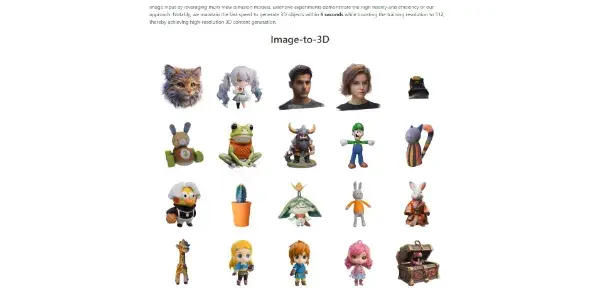LGM 3D

A project to create high-resolution 3D models from text or images. Using a technique combining multi-view Gaussian properties
LGM 3D: Generating High-Resolution 3D Models from Text and Images
LGM 3D is a groundbreaking project available on GitHub that leverages a novel technique combining multi-view Gaussian properties to generate high-resolution 3D models from either text descriptions or input images. This innovative approach offers a powerful and accessible method for creating 3D content, opening up new possibilities for various applications.
What LGM 3D Does
LGM 3D's core function is the automated generation of detailed three-dimensional models. Unlike traditional 3D modeling which requires extensive manual effort and specialized skills, LGM 3D allows users to input either a textual description of the desired model (e.g., "a detailed model of a futuristic spaceship") or an image, and the AI will generate a corresponding 3D representation. This process utilizes sophisticated algorithms that analyze the input and synthesize a 3D structure with remarkable fidelity. The key innovation lies in its use of multi-view Gaussian properties, which allows for the creation of models with higher resolution and more accurate geometric details than many existing methods.
Main Features and Benefits
- High-Resolution Output: LGM 3D excels in generating 3D models with significantly higher resolution than many comparable tools, leading to more detailed and realistic results.
- Text-to-3D and Image-to-3D Capabilities: The tool's flexibility allows for model creation from both textual descriptions and input images, providing diverse input options for users.
- Ease of Use: While the underlying technology is complex, the user interface (assuming one is developed or readily available through the GitHub project) aims for user-friendliness, making the process accessible even to those without extensive 3D modeling experience.
- Open-Source Accessibility: Being a GitHub project, LGM 3D benefits from the open-source community, fostering collaboration and potential for future improvements and extensions.
Use Cases and Applications
The capabilities of LGM 3D translate into a wide range of practical applications across diverse industries:
- Game Development: Quickly prototyping game assets, creating environments, and generating character models.
- Film and Animation: Producing realistic 3D models for visual effects and animation sequences.
- Architectural Visualization: Generating 3D models of buildings and interiors from blueprints or sketches.
- Product Design: Creating rapid prototypes of new products from initial designs or concepts.
- Education and Research: Providing an accessible tool for teaching 3D modeling and facilitating research in computer graphics.
Comparison to Similar Tools
While several other tools offer text-to-3D or image-to-3D functionalities, LGM 3D distinguishes itself through its focus on high-resolution output and its unique multi-view Gaussian approach. Direct comparisons require a detailed benchmark against specific competitors (e.g., other open-source projects or commercial software like Blender, Substance 3D). However, the key differentiator will likely be the level of detail achievable in the generated models and the ease of use for achieving such detail.
Pricing Information
LGM 3D is currently available free of charge. As an open-source project, access to the software and its source code is freely available via GitHub. However, it's important to note that users may need to cover the costs associated with running the software, depending on their hardware and computational resources.
Conclusion
LGM 3D represents a significant advancement in AI-powered 3D model generation. Its ability to produce high-resolution models from both text and images, coupled with its open-source nature and potential for diverse applications, positions it as a valuable tool for professionals and enthusiasts alike. Further development and community contributions will likely enhance its capabilities and expand its reach across various industries.